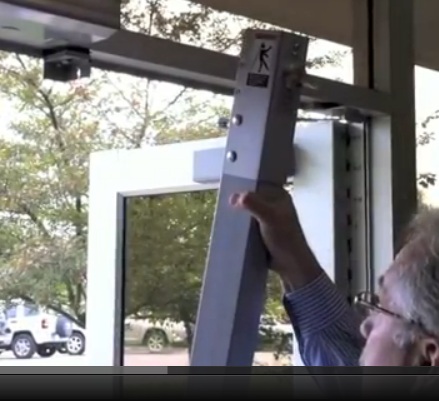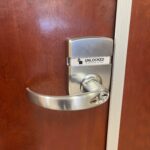Way back in hardware school we were taught that rim panic hardware with a removable mullion is the most secure and maintenance-free application for a pair of doors. Most facilities prefer mullions instead of vertical rod panic hardware, which can be difficult to install and to keep properly adjusted. On the other hand, most architects request concealed vertical rod panic hardware, to avoid seeing the mullion or rods. I think the benefits of the mullion far outweigh any aesthetic issues.
I have had many architects ask for clarification of where the removable mullion mounts, often questioning whether the mullion has to sit between the doors. The removable mullion actually sits behind the doors, where the rim panic hardware latches into it.
In the “Olden Days,” removable mullions were installed with screws, and when the mullion was removed to allow the passage of large equipment through the opening, it would often end up reinstalled with a screw or two less each time. The option of having a key-removable mullion makes it easier to remove and reinstall the mullion without jeopardizing security.
I received a link to this video the other day, and I thought it might be helpful to illustrate the location and installation of a key-removable mullion. Don’t forget that when you use a mullion you need to measure the clear width of the opening from the face of the door open to 90 degrees, to the edge of the mullion, which reduces the clear width by about 1″. Each leaf will need to provide 32″ of clear width if that leaf is required for egress or an accessible entrance.
Do you have a preference for rim panics with mullions or vertical rods – concealed or surface-mounted? Tell us why!
You need to login or register to bookmark/favorite this content.






Lori,
Several years ago I was writing a specification for a middle school. The architect wanted vertical rod exits at the exterior doors and he did not want to see any of those “ugly” mullions. I knew all he really cared about was the front entrance so I put surface vertical rods on this pair but rim with mullions on all the other exterior doors. He was happy because the front entrance did not have the mullion.
Guess which doors were constantly out of adjustment? Guess which doors the GC and even my people had to go back and re-adjust at least 5 times in one year. Guess which doors kids continually broke into by shaking until the rods popped open. That’s right; the front entrance which was well lit and visually exposed to the road. The back door by the woods which had rim devices and mullion was never broken into.
It is amazing the misconceptions about mullions vs. vertical rods. Every year in DHI school, before the exit device presentation, we ask the students which is more secure. They always pick vertical rods because they think that the two points of latching is more secure than one point. The other misconception is that mullions interfere with or impede traffic flow. It is actually the opposite because it gives two distinct paths of travel. We always ask them how many times have they tried to enter a pair of doors as someone is exiting and they both hesitate because they both want to occupy the same space (the middle of the opening). So it turns out that mullions are not only better for security, they also help with traffic flow.
Hello Lori,
even though I never attended a hardware school or class on doors, but YES I remember the screw type mullions, all the schools i went to used them, they had a 2 or 3 screw bracket that also if you lost the other piece of the bracket, it was useless.
finally nice to see they make them with a lock cylinder so you can use a KEY instead of having a screwdriver each time you want to make a double door accessible to heavy equipment or tables.
new method sounds reasonable and easier to do then using screws, new method sounds to me alot easier for one person to do and quicker.
as for rim panics and vertical rods, never worked on any of the panics other then tighten loose screws on crossbars, i would have to say that surface mount would be easier to get to when it comes to replacing a worm part, with a concealed they appear that you would have to take the door apart to get to it.
-Jess the door closer doctor
Hi Lori…
I think you make a good case for center mullions, but unfortunately they are not permitted in new construction healthcare occupancy smoke compartment barrier doors. (See 18.3.7.8 of the 2000 edition of the Life Safety Code).
They are still permitted in existing healthcare occupancies, and the difference between existing and new construction is when the plans for construction (or renovation) of the facility were approved: If before March 11, 2003, then it is considered by the federal agency Centers for Medicare & Medicaid Services (CMS) to be existing, and if on or after March 11, 2003, then it is considered new construction. Why March 11, 2003? That is when CMS adopted the 2000 edition of the Life Safety Code, which we are still on. Previously, we were on the 1985 edition, which was horrible.
Hopefully, CMS will adopt the 2012 edition of the LSC within the next year or so.
Hi Brad –
You’re right! I knew there was another code-related thing I wanted to mention but by the time I got there I forgot what it was (it was a little late). Mullions are not allowed on cross-corridor doors in health care but I wouldn’t typically use them there anyway. I am going to revise the post a little bit for clarity.
– Lori
Good Morning all,
I work for an institution in Colorado that is built on a hill side, so basically, everything is always moving. I prefer to use rim type exit devices with a key removable mullion on double doors. This virtually eliminates the constant adjustments required on vertical rod exit devices in doorways that are prone to movement.
On new construction, I always recommend mullions be installed versus vertical rods, less to go wrong, and less expensive as well.
I just wish I could find hinges that would adjust up/down in/out, this would make my life much easier!
Josh
look around josh, i think there are adjustable full length hinges that might meet your needs…
We use these alot in schools. Several things come to mind. 1) Thumbturns can be substituted for the key cylinder if the mullion needs to be removed frequently. Back to the age old argument of security vs. convenience. 2) Fire rated removable mullions must be used (obviously) in fire rated openings. 3) The floor anchor remains on the floor when the mullion is out. A floor buffer may now fit thru the opening but may not clear the anchor. And the fire rated anchor is taller than the standard anchor. 4) Although an electric strike can be added to a removable mullion it is a problem waiting to happen. The wiring may (should) have a disconnect, but often this doesn’t get undone during the removal and the wiring gets ripped apart. Often the mullion is then reinstalled with a non-functioning strike. 5) Finally the architect needs to remember that these are for rim devices – a standard mortise classroom lockset doesn’t work.
Hi Lori
In my opinion, 2 rim exits x removable hardware mullion is the best and most secure application.
A DHI instructor (Bill Elliot DAHC) once quipped to a class I was in [and probably many others] that even though it is usually the best application, don’t use it on the front entry to a church because it is very awkward when you have to turn the casket sideways to get it in and out the door during a funeral. 🙂
Jim
ummm… so have the mullion pulled during the funeral… and just how WIDE, (not length) IS that casket that can’t fit through 2 open doors (pair) ???